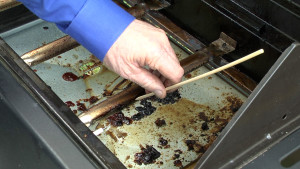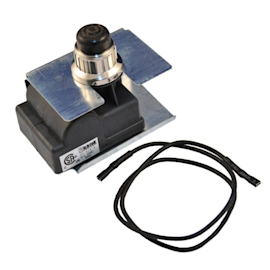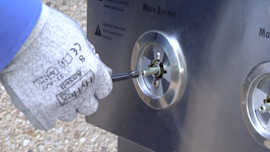- Kenmore refrigerator water filters
- Whirlpool refrigerator water filters
- Samsung refrigerator water filters
- GE refrigerator water filters
- LG refrigerator water filters
- Frigidaire refrigerator water filters
- KitchenAid refrigerator water filters
- Maytag refrigerator water filters
- Kenmore Elite refrigerator water filters
- Estate refrigerator water filters
- GE Profile refrigerator water filters
- Amana refrigerator water filters
- Bosch refrigerator water filters
- Dacor refrigerator water filters
- Electrolux refrigerator water filters
Gas grill won't ignite or light video


This video from Sears PartsDirect shows what to do when your gas grill won't light, starting with some easy troubleshooting like checking your propane tank level and your starter battery. If that doesn’t work, our more advanced troubleshooting takes you through resetting the pressure regulator, cleaning the grill’s burner ports and removing the burner tubes to clean residue found on the inside of the tubes. Additional troubleshooting involves checking for cracked igniter electrodes and using a multimeter to test voltage through the spark module.
Check out our DIY gas grill repair help page for more troubleshooting advice, repair guides and grilling articles.
Supplies you might need
Batteries
Lighter
Dishwashing liquid
Water
Small container
Soft brush
Rag or cloth
Wire brush
Screwdriver
Pliers
Bamboo skewers
Coat hangar, small bottle brush or canned air
Multimeter
Pressure regulator
Spark module
Hi, Wayne here from Sears PartsDirect. Today we're going to talk about what to do when your gas grill won't light. You're ready to start grilling, but your grill isn't cooperating.
Start with the obvious troubleshooting. Make sure that you have the valve on your propane tank fully open. Turn the valve left (or counterclockwise) to open it.
Check propane level and ignition system battery
If the valve's open, check the propane level in the tank. If you’re not sure how much gas is in the tank, check out this video to see how to check the level of fuel in a propane tank. Refill the tank if it's empty or nearly empty.
If you try to start the grill and find the ignition system isn't sparking, check the battery if your grill igniter uses one. If the grill lights after you replace the igniter battery, then you've solved the problem.
If you get through this basic troubleshooting without resolving the ignition problem, try lighting the grill using a lighter to determine whether the burners are getting any gas.
If the burner lights, then the grill has a spark ignition system problem. Skip to the section called "Check igniter electrodes."
Reset the pressure regulator
If the burner won't light using a lighter, then you'll need to reset the pressure regulator. The pressure regulator has an internal flow-limiting device that prevents gas flow from the tank when it detects a leak. Sometimes this device trips in error. Here’s how to reset the pressure regulator.
Open the grill lid, and then turn off all grill burners.
Shut the tank valve and disconnect the supply hose from the tank.
Turn on all the burner knobs fully and wait 2 minutes to allow the gas to dissipate from the manifold and gas lines.
Next, turn all the burner knobs off again and reconnect the supply hose to the tank. Slowly open the tank valve and wait 30 seconds for the gas pressure to equalize in the gas lines and manifold. Now try lighting all of the burners.
Check for a gas leak
If the burners light after you reset the pressure regulator, then a tripped flow-limiting device likely caused your burner ignition failure. Because a gas leak may have caused the device to trip, check all gas line connections for leaks using a soapy water solution.
Shut off all gas grill burners and the tank valve and allow the grill to cool completely.
Mix a 50/50 solution of dishwashing liquid and water and brush the solution on all gas line connections. Refer to your owner's manual to see where all the gas line connections are on your grill.
Open the tank valve and check all gas line connections. If you see bubbles forming around a gas line connection, that indicates a gas leak.
Shut the tank valve and tighten the connection or replace the leaking component.
Wipe the soapy solution off the connections after testing for leaks.
If you find no gas leaks, then the flow-limiting device tripped in error. You can prevent nuisance trips of that device by following these 3 tips.
When preparing to use the grill, make sure that you have all burner valves closed before you open the tank valve. Opening a burner valve before you open the tank valve can simulate a leak, causing the flow-limiting device to trip.
Open the tank valve slowly when you're preparing to use the grill because opening the tank valve quickly can trip the flow-limiting device.
When shutting down your grill after use, turn off all burner valves before you shut the tank valve. Shutting the tank valve with burner valves still open can cause the flow-limiting device to trip because it detects a leak.
Check for burner clogs and corrosion
If the burners don't light after resetting the pressure regulator, then the pressure regulator may be defective or you may have a problem with the burners. Let’s check the burners for clogs, corrosion and alignment problems.
First, shut off the tank valve and open all burner valves. Wait 2 minutes to allow gas to dissipate from the manifold and gas lines and then shut all burner valves.
Remove the grates and flame tamers and examine the burners for corrosion. Replace any corroded burners.
Check the burner ports for clogs. Use a wire brush to clear dirt and food residue from burner ports.
Disconnect the carryover tubes from the burners. Remove the cotter pins and pull the burners off. Clean the inside of the burner tubes using one of these methods:
Bend a small hook on the end of a stiff wire like a straightened coat hanger. Run the hook through each burner tube several times to clear out clogs.
Clear internal burner tube clogs with a small bottle brush.
Blow canned or compressed air through the burner tube opening.
Once you’ve cleaned the burners and burner tubes, reinstall the burners, making sure to properly align the burner tube venturi over the burner orifice. Misalignment of the burners over the orifices can prevent burners from lighting because gas won't enter the burner tubes.
Let’s open the tank valve and see if the burners light now. If not, then you likely need to replace the pressure regulator and hose assembly. Once you get that fixed, you should be able to light the burners and get back to grilling.
If you skipped to this section because you were able to light grill using a lighter, we'll check the spark ignition system next.
Check igniter electrodes
First, check for spills on the burner and/or igniter that could interfere with sparking. Clean off spills or residue from the burner and/or igniter.
If your grill has more than one igniter electrode, check all the electrodes for sparking. This grill has an electrode on the side burner and one on the main grill burner. If only one burner isn't sparking, check the wiring connections between the spark module and the electrode for the igniter that isn't working. Reconnect or repair any broken wires that you find.
If none of the igniters sparks, check the wiring for all of them and replace or repair any broken wires.
If you didn't find any wiring problems, pull out each electrode and check its insulator for cracks. A crack in an insulator can cause the spark to go through the crack to the frame of the grill instead of sparking at the burner to ignite the gas. Replace the igniter electrode for any insulator that has a crack.
Test grill’s ignition module
If the insulators are okay, then the ignition module, also known as the spark module, could be defective. Using a multimeter, check for DC voltage between the electrode and the burner. With your meter set to check DC voltage, touch one meter probe to the electrode prong and the other meter probe to the burner tube, then press the ignition button.
If you don't measure any voltage, remove the ignition module. Check for voltage between the ignition module spade and bare metal on the grill cabinet. Touch one meter probe to the ignition module spade and the other meter probe to bare metal on the grill. If you measure no DC voltage, replace the ignition module.
Once you figure out why the grill won't ignite and fix the problem, you can get back to grilling that perfect meal you're known for. I hope this video helps you out today. Check out our other videos on the Sears PartsDirect YouTube channel and be sure to subscribe to find out when we post new videos.
Symptoms for gas grills
Choose a symptom to see related gas grill repairs.
Main causes: nearly empty fuel tank, faulty pressure regulator, burner tube clogs, bad burner tube alignment to gas valv…
Main causes: empty fuel tank, tripped flow-limiting device on the pressure regulator, faulty manifold valves, burner tub…
Main cause: worn wheel…
Main causes: damaged or dirty flame tamers, corroded firebox, accumulated grease and debris in the grease pan…
Main causes: clogged burner tubes, cracked insulators on igniter electrodes, wiring failures, bad ignition module, manif…
Repair guides for gas grills
These step-by-step repair guides will help you safely fix what’s broken on your gas grill.

How to replace a gas grill wheel
Replace a broken or damaged wheel in less than 15 minutes.…
Repair difficulty
Time required
15 minutes or less

How to replace a gas grill igniter electrode
Replace the igniter electrode on your gas grill if it won’t light the burner.…
Repair difficulty
Time required
15 minutes or less

How to replace a gas grill ignition module
Follow these steps to replace the ignition module if it doesn't produce a spark. …
Repair difficulty
Time required
15 minutes or less
Articles and videos for gas grills
Use the advice and tips in these articles and videos to get the most out of your gas grill.

Learn about all the convenient features on our Sears PartsDirect website that make your parts purchases easier.…

Get answers to frequently asked questions about Sears and Sears PartsDirect.…

A conversion kit and a few simple tools are all you need.…